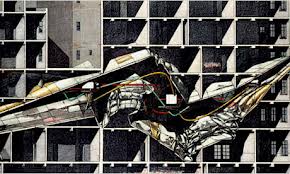Lebbeus Woods, Quake City (1995).
Contemplating and exploring the worlds envisioned by Lebbeus Woods, whose death last October occurred while the lobster & canary were in the grips of Superstorm Sandy here in NYC, i.e., we are still processing his departure and thinking through the impact of the polymathic, iconclastic Woods on art, architecture, urban planning and design.
Woods, Zagreb Free-Zone (c. 2000?)
Woods, Berlin Free-Zone 3-2 (1990)
Very few of his architectural renderings were ever built, though he insisted that they should-- and one day would--be. A true visionary, who defied convention and walked over boundaries.
Not enough time or space this morning to delve more deeply, but-- if I had such for a full-length essay--I would think of Woods in terms of other multi-disciplinary, slantwise form-makers: Piranesi, Joseph Michael Gandy, Boullee (The Cenotaph for Newton broods as a possibility over so much of modern architecture), Motherwell, Bontecou, Duchamp, Ernst... Ridley Scott and Giger (Woods is credited with helping them craft the settings for Aliens 3)...
For more on Woods, click here, and here.










